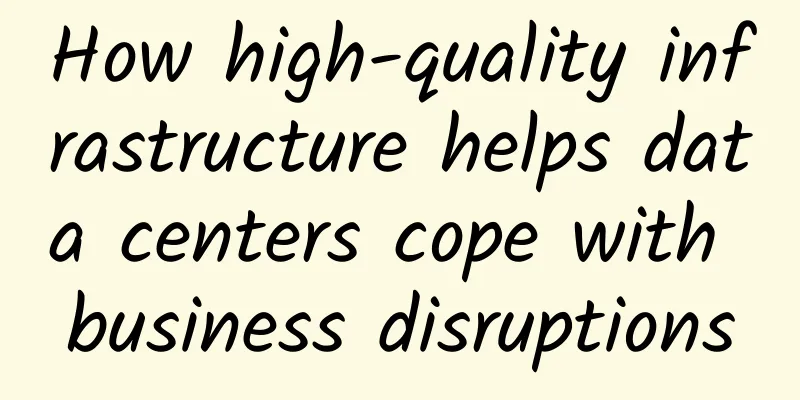How high-quality infrastructure helps data centers cope with business disruptions

|
As today's corporate organizations are actively building themselves into a transformational enterprise, the focus of your company's IT department needs to shift from simply solving business interruption areas. However, to move beyond a reactive approach to responding to and addressing the drivers of business disruption, your business will need a more comprehensive, flexible data center infrastructure. By referring to this research report from Frost & Sullivan, I believe it will help readers understand how to build a better infrastructure so that your organization can take full advantage of powerful automation tools, high-performance management and reporting platforms, and achieve ideal flexibility. A few years ago, IT departments were only considered to be in the role of providing services to business departments. Today, IT leaders are at the forefront of their companies' entry into the digital age. Today, technology is increasingly considered a key driver of achieving corporate strategic business goals, including driving revenue growth, market expansion, and improving customer satisfaction; and IT leaders are faced with the challenge of keeping their business running while also further identifying and leveraging innovative solutions that can drive growth.
No matter how many disruptive technologies organizations have adapted to in the past, we know there are more to come. Today’s successful IT leaders have deftly handled the evolution from mainframes to PCs to cloud services; the move from desktops to laptops to tablets and smartphones; from shared drives to collaboration tools; from “800” employees to omnichannel support; and from static websites to sophisticated customer and employee portals. But even these leaders will need to do more to ensure their organizations are ready for the next generation of disruptive technologies. The fact is that in the future, IT will be less about dealing with disruptions as they arise and more about building a nimble, “change-resilient” organization. That means investing in infrastructure, operations, and even the technical skills to build adaptability so that your organization can lay the foundation for the disruptions that may come to your data center in the future. So how do you achieve this? Not by retrofitting your data center with forklifts (which would cause unnecessary disruption and expense). Instead, it’s best to develop a strategy for the future: one that allows your company to best prepare for the various known and unknown disruptions that can cause business disruption. In this article, we will explore the impact of disruptive technologies on enterprise business operations and their impact on data center infrastructure. We define the ideal IT environment and propose a flexible, composable infrastructure to achieve this ideal IT environment. The most important factors causing business interruption No doubt you have already addressed many of the technical disruptions that your business colleagues have requested or your own IT initiatives. However, with the current increase in the flow, speed and disruption of data being stored, you may find that your data center is currently under tremendous pressure. Below are the top six factors that impact enterprise business and IT operations, and we'll also explain how your data center infrastructure can help or hinder this process. 1. Big data and analytical technologies that influence business decisions Nowadays, businesses in various industries are increasingly relying on various data information to make critical business decisions. Due to the increase in business process automation and the adoption of the Internet of Things, enterprises are collecting and using more data information than ever before. Thanks to a variety of complex analytical software, enterprises are able to better analyze and utilize this data. Data remains active for a longer time to support enterprises in meeting regulatory compliance requirements and trend analysis. Moreover, since many business decisions are data-driven, enterprises are forced to have a high-availability environment to store the main data in the environment. Among the respondents surveyed by Frost & Sullivan, one-third of IT leaders listed "the growth of data storage" as the primary challenge of their data centers. The increase in business analytics workloads may strain existing data center infrastructure and configuration. For optimal performance, analytics-intensive workloads require high-performance systems designed to support high input/output operations per second (IOPS) and fast processing. To support some workloads, your data center's analytics software may need to pull data from multiple sources and databases on-premises and in the cloud, and provide responses to different users and systems in real time; this requires a closer look at network configuration. For mission-critical applications, you need to ensure that your backup and recovery solutions are sufficient to handle the volume and rate of change of data. And for sensitive or regulated data, you need to configure primary, backup, and storage data with appropriate security profiles. 2. 24/7 user productivity Technology has been a productivity enabler dating back at least to the introduction of the first calculator. In recent years, the latest (disruptive) view is that businesses can process transactions anytime, anywhere. Thanks to the development and popularity of various emerging technologies, even the smallest businesses can break free from the constraints of the "working day" and take full advantage of the global market. The company's employees, business partners, and even customers can communicate and interact smoothly and seamlessly with any other place and business through any network, device, and platform. The impact on the data center is obvious: enterprise IT departments need to be prepared to deliver data and applications securely to users and with optimal performance to the platforms, devices, and networks (i.e. mobile, Internet, or private enterprise networks) of their choice. Communication and collaboration tools must also be enabled on multiple platforms to ensure maximum productivity. All applications must be maintained in high availability mode. 3. The business department is not authorized An interesting phenomenon in recent years is that IT technology decisions are no longer limited to IT departments. Instead, as technology becomes more accessible to non-technical users, employees from other business areas will be responsible for technology decisions in their own departments - in some cases, circumventing heavy IT processes in order to smoothly obtain the tools they need to do their jobs. According to a global survey by Frost & Sullivan, more than 80% of business unit (LoB) employees purchase business software without authorization from the IT department; the most important reason is that the IT process is too slow or cumbersome. In response, enterprise IT departments are working to work with the LoB to better address agility and market responsiveness to meet business unit goals. This includes deploying methodologies such as DevOps, which streamlines and automates the software development and deployment process. Instead of waiting for lengthy release cycles to deploy software and updates, DevOps supports continuous integration, testing, and deployment so that changes and adjustments can be made quickly. DevOps is often a catalyst for process change, with IT organizations replacing waterfall processes in a collaborative way. However, relying on people and processes alone cannot meet the deployment speed expected by business units. Flexible and easy-to-configure data center infrastructure is also required. In addition, in order to understand the impact of their decisions at the product or project level, business unit leaders need to understand visibility and actual usage costs. 4. Increased customer expectations In today’s fast-paced business environment, where new competitors can appear anywhere around the world, in adjacent industries, or even nowhere, companies need to work harder than ever to retain customers. If they are disappointed, customers may quickly find another supplier elsewhere, perhaps leaving negative feedback on social media sites. However, if they are satisfied with your service, they will reward you with their customer loyalty. The most loyal customers often view relationships as partnerships, which means they want to be involved in your business. They expect to interact with you through multiple channels and get an immediate response - whether it is through phone, email, live chat tools, mobile applications, self-service portals, web pages or social media. In addition, they expect to have always-available self-service access to their account data and order systems related to inventory and delivery systems. Gaining customer loyalty requires a combination of focus (building a customer-centric business ethos); skills (ensuring all employees are trained to prioritize customer needs); processes (incorporating customer feedback and input into business processes); and most importantly, infrastructure. Data center infrastructure needs to be agile and flexible enough to respond to changing customer needs. It also needs to support high availability and high performance so that customers are not forced to leave your business due to poor performance or system downtime. 5. The rise of automation and standardization tools As with the Industrial Revolution, automation and standardization are perhaps the biggest productivity gains of the digital age. As deployment models (such as cloud); development methodologies (such as DevOps); and integration capabilities such as Platform as a Service become core parts, automation and standardized software will offload manual and customized tasks, reducing employee productivity and business agility. This leads to lower costs, shorter deployment times, and higher quality (because human-induced errors are minimized). However, to fully leverage auto-provisioning capabilities, data centers must be equipped with flexible infrastructure, middleware, and management platforms, all integrated to support frequent changes. 6. The emergence of hybrid cloud Perhaps the most heralded disruptive technology of the past decade is cloud computing, a scalable method of delivering IT resources on demand. While the first cloud to capture the market's imagination was the public cloud, enterprises quickly made it clear that they wanted to use the public cloud as an adjunct to, not a replacement for, their own data centers. In a Frost & Sullivan survey, 86% of cloud users said they use a hybrid cloud environment, linking their on-premises data centers with public cloud services. But a hybrid cloud means not only hosting some of your enterprise's applications in the cloud service provider's data center, but also being able to host other applications in your own data center. Enterprises are increasingly looking to segment workloads in the environment; for example, placing web servers in the cloud and secure databases on-site. To ensure that workloads provide the appropriate level of performance, availability and security, data centers need appropriate infrastructure systems and management platforms to support the unique needs of hybrid workloads. Why disruptive technologies are driving new thinking about data centers Many IT leaders have determined that many of these disruptive technologies are not easily “fixable” by themselves as standalone technologies. For example, vendors do not sell pre-packaged “customer-expected” solutions (whether hardware or software), nor do they sell “employee empowerment” packages. When applications do exist (for example, to support data analytics or hybrid cloud), the solutions often involve only addressing a portion of the overall challenge. Because technology rarely exists in a vacuum, there are few applications or platforms or solutions that are completely isolated from one another; and there will be even fewer in the future. Yet, this is how traditional data centers are configured, with custom-deployed software on specialized servers. This “siloed” approach increases cost and complexity in the data center, hinders business goals, and creates the following challenges:
To minimize these challenges, enterprise technology leaders should not address these disruptive forces (whether threats or opportunities) with standalone solutions. Instead, they should prepare for a "composable" infrastructure for the data center of the future. The data center of the future will be built on "composable" infrastructure What is "composable" infrastructure? Hewlett Packard Enterprise (HPE) introduced their "composable infrastructure" term to represent data center hardware, middleware and management software that are designed to be highly flexible and functional; optimizing the performance of traditional architectures and workloads as well as new cloud-native applications. Not to be confused with "modular" infrastructure, composable infrastructure is more than just ensuring that hardware components are interchangeable. Composable infrastructure leverages powerful automation tools, high-function management and reporting platforms, and application programming interfaces (APIs). It enables your enterprise to manage all infrastructure resources (physical and virtual, general-purpose and application-optimized, based on data center on-site scenarios and cloud services) to provide the best combination of performance, security, scalability, and cost for your workloads. Just like a child's Lego blocks, with the ability to replicate blocks as needed and programmed instructions, you can build your own "Ninja Temple" today and configure a working race car tomorrow. Composable infrastructure provides the following capabilities:
Since composable infrastructure is an approach to data center architecture, IT leaders can start by developing a roadmap. Here are some valuable steps to help companies make this transition smoothly: Evaluate the applications currently running on traditional data center infrastructure. Can they consistently deliver the right level of performance at an acceptable price? Assess whether your infrastructure is suitable for your most demanding workloads. Are you spending too much time and energy on maintenance tasks? Is the hardware your applications are running on ready for an update? As hardware reaches the end of its life, or additional capacity is needed, consider installing a high-performance system that provides greater flexibility for the future. Install a robust automation and management platform that provides visibility and consistent functionality across multiple environments and deployment models. By introducing a platform like HPE OneView, you can eliminate the complexity associated with disparate management tools while providing IT and business unit stakeholders with the visibility they need to make business decisions. Give your current cloud applications a fresh start and prepare for future applications and technologies by deploying an API that can be tightly integrated with multiple environments. Look for an API that lets you centralize resources so you can automatically deploy and scale cloud applications across environments. Communicate with your IT partner about innovative, new on-demand consumption financing models that enable your investment and your organization’s readiness to respond quickly to changing business needs. Look for services that provide resource “buffers” to extend existing data center infrastructure, allowing you to quickly scale workloads without paying for unused capacity. The pace of technological innovation shows no signs of slowing down. To prepare for tomorrow's challenges, or to introduce some new disruptive technology, your enterprise data center will need an IT department that is fully adapted and ready. This may require new processes to reflect a closer working relationship between business units and IT; and between developers and operations. This may require new skills as IT experts broaden their horizons. A more flexible infrastructure is definitely needed.
The good news for enterprise IT leaders is that composable infrastructure is the way to engineer data centers for the future. You can build a roadmap that supports both traditional workloads on existing infrastructure and new applications built for the scalability and rapid deployment of the cloud. The goal of composable infrastructure is to provide your business with a technology foundation that is flexible enough to support today’s needs (people, processes, and technology) and to prepare for the unknown future. If you can do this for your business units, then your company will be able to not only adapt but also actively embrace future disruptors. |
<<: Make the network run autonomously like a driverless car
Recommend
Attention to those whose phone numbers begin with 13, 15, 18, etc.! There may be a big problem with your data plan!
Users whose mobile phone numbers begin with 13, 1...
VIAVI Demonstrates Validation, Verification and Visibility Solutions for 5G at Mobile World Congress 2019
VIAVI Solutions, Inc. (NASDAQ: VIAV) will showcas...
The 17th China Enterprise Annual Selection List for 2022 was announced: Juniper Networks China CTO Jing Youhao won the 2022 IT Industry Network Outstanding Contributor
In November 2022, the "China Enterprise &quo...
Multi-process communication methods and a series of problems
[[434195]] This article is reprinted from the WeC...
HostYun: VPS in the United States/UK/Russia/Korea/Hong Kong starting at 16 yuan per month, with CN2/AS9929/large bandwidth/high defense and other features available
HostYun is an old niche personalized IDC founded ...
Benefits of 5G for IoT
While IoT devices aren’t the ones that will benef...
Three major 5G concepts and four key technologies
The situation is tense and there is little conten...
Actual combat case: The hospital egress router is cut over. Once the intranet device is connected, the router interface cannot be accessed? Amazing!
Background XX Company is an engineering company s...
It's over! Something big has happened to TCP!
= [[335538]] This article is reprinted from the W...
How data centers work today and in the future
The data center of the future will rely on cloud ...
Maxthon Hosting: Unpopular CN2 Data Center, German CN2/Netherlands CN2 (Anti-complaint), 2G memory package starting from 60 yuan per month
In January, we shared the news about Maxthon'...
Which of the three major operators has the first chance in 5G research and development? How will life be disrupted?
[[177286]] It is reported that my country will la...
Embrace cloud desktop and easily overcome the three major pitfalls of desktop application innovation
From the early "863" and "Core Hig...
Data Cabling: How to Plan Ahead?
Data cabling is an important channel for enterpri...
No one is forcing us to upgrade to 5G? The latest regulations are released: those who force 5G packages will be severely punished
I guess everyone here is already familiar with th...









